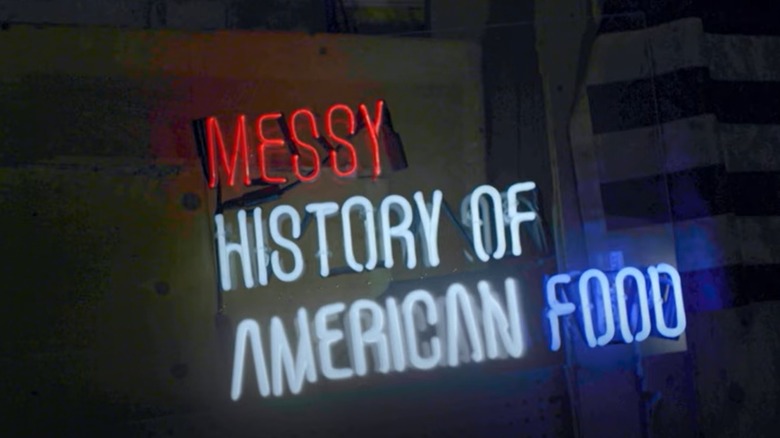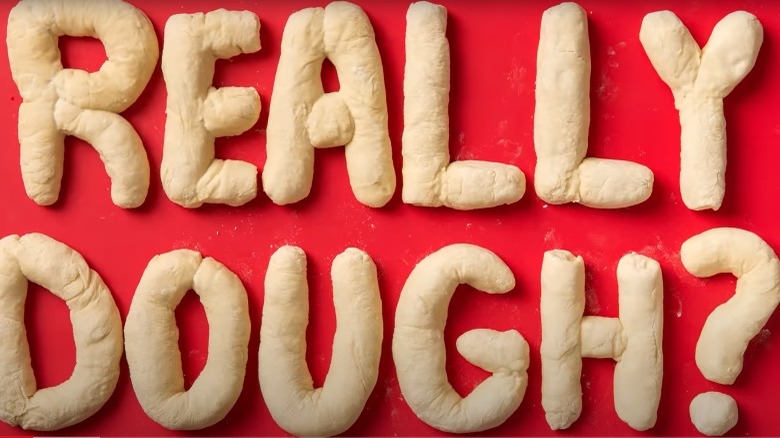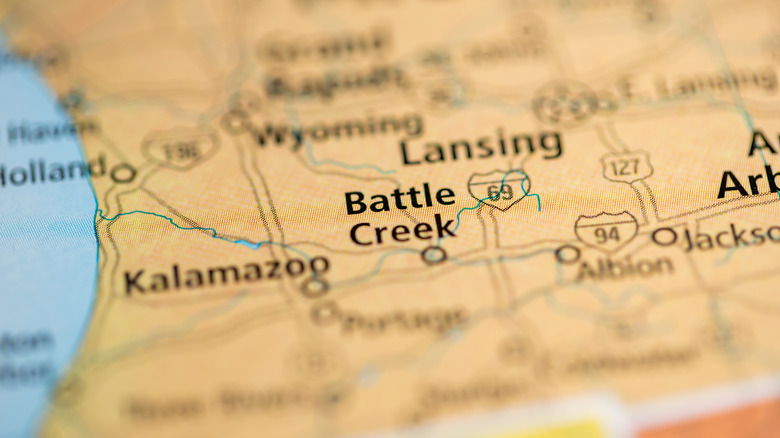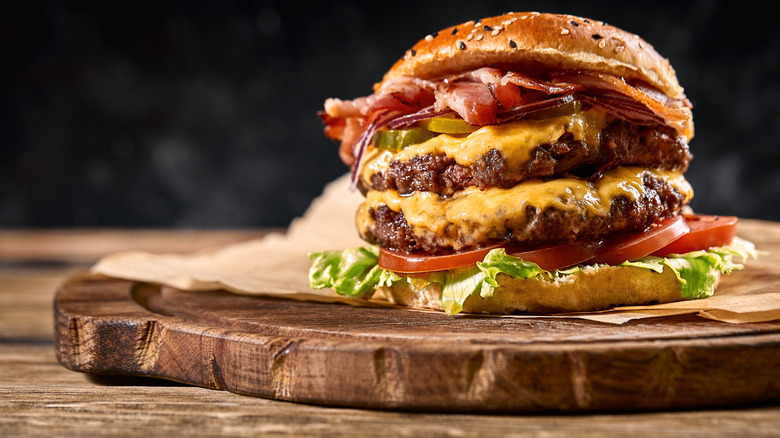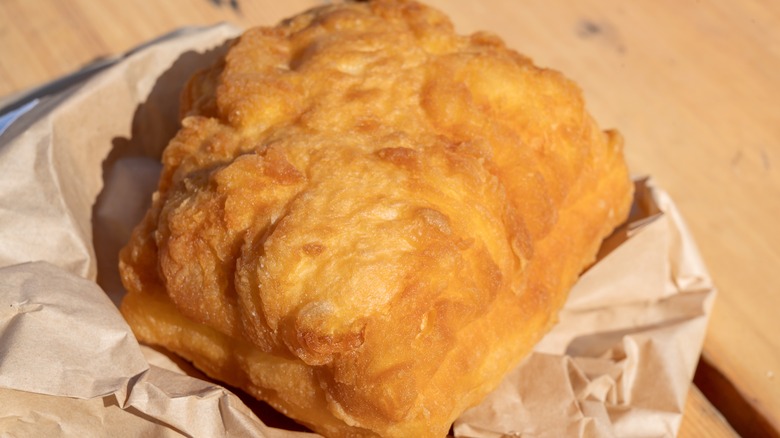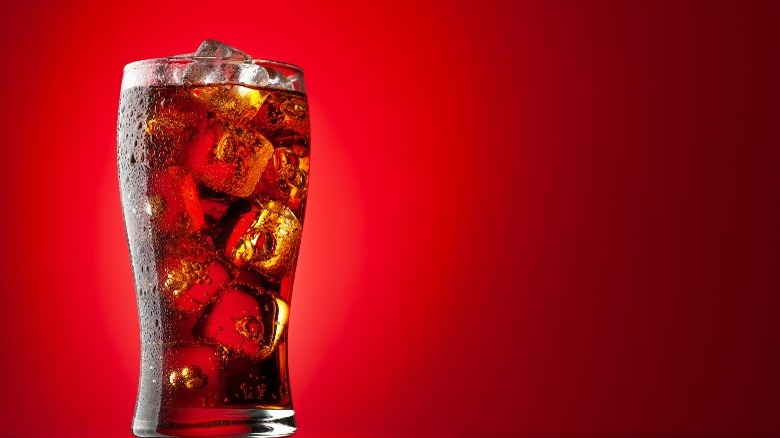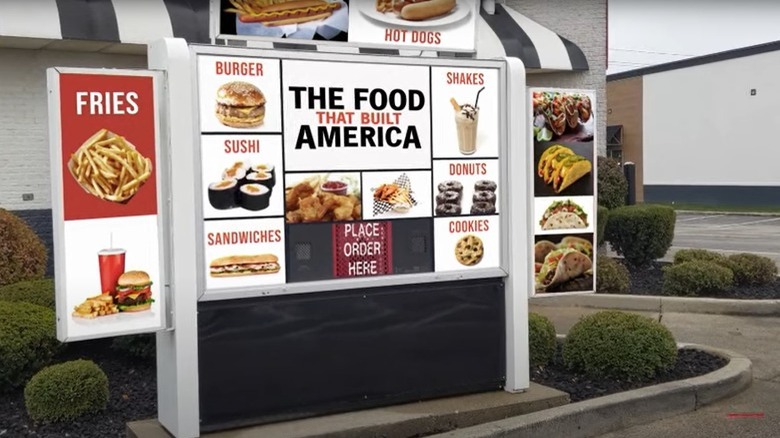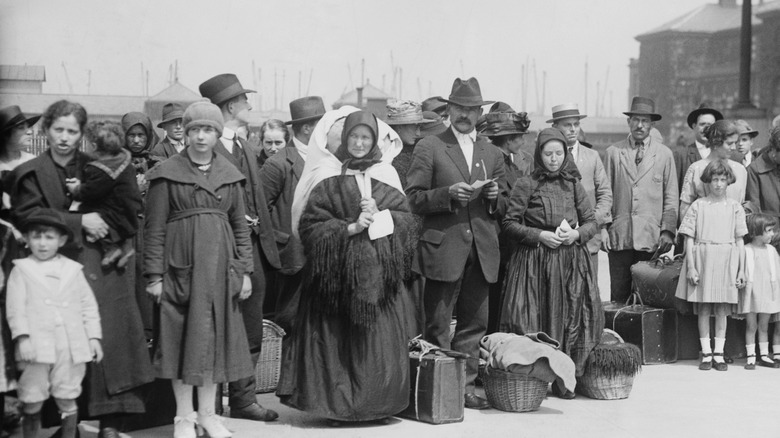The Untold Truth Of Messy History Of American Food
We may receive a commission on purchases made from links.
You can stop asking Alexa for trivia about your food because there is a new show that covers much of it. Produced by Thrillist and Group Nine Studios, "Messy History of American Food" is a six-part series covering the history of some of America's most popular foods including burgers, soda, chocolate, bread, cereal, and chicken wings (via Real Screen).
As explained by Thrillist, the show will look at "the ways Americans have been making, marketing, and consuming our favorite foods" some of which have a richer history than most probably realize. The episodes attempt to pack all that history about each of the food items in short 30-minute episodes.
Some fun facts the show will specifically focus on will include why sliced bread was such a big deal, how Hershey's chocolate came to have its distinct taste, and "why exactly so many burger chains decided that the best way to market their product was to film supermodels eating them while washing cars" (per Thrillist). So, before you get settled with your bucket of popcorn to get your history lesson on your favorite foods, here is a run-down of what you can expect from the show.
Thrillist produced the show
Before taking a deep dive into the "messy history" of American cuisine, Thrillist, the online food, drink, travel, and entertainment website, had a slew of other shows including one focused exclusively on pizza, called "Really Dough?" (via Group Nine Media).
The show debuted in 2018 and Scott Weiner, who holds a Guinness World Record for collecting the largest number of pizza boxes and runs Scott's Pizza Tours that takes people on pizzeria-themed walking and bus tours around NYC to try out different kinds of pizza (even one made with ramen). The gist is that Weiner then has to decide if unusual pies can even be considered pizza due to their eclectic toppings. Weiner would check in with pizza "purist" Mark lacono, owner of a Brooklyn pizzeria called Lucali, to confirm whether some of the 'zas out there are authentic enough to bear the name "pizza" (ramen pizza, per lacono, does not fit the pizza bill).
Per Group Nine Media, Thrillist also launched a series on chefs who have established full-fledged cooking businesses via Instagram ("Instachef"); another on lesser-known local eats ("Gatekeepers"); and yet another exploring a question that we all had in mind but were hesitant to ask: which fast food (forget cheese) goes well with which wine? ("Somm To Go").
While all these shows are or were all about food, none of them dared to ruffle up the strange and messy stories of American cuisine like their new series does. And "Messy Foods" starts appropriately, as many of us have started our days for years, with the origins of breakfast cereal.
The crew traveled to Battle Creek, Michigan, to find out the origin of cereal
While most of us were happy having our Frosted Flakes without wondering about its roots, the team behind the show "Messy History of American Food" obviously wasn't. They toured the Cereal History Exhibit at Calhoun County Visitors Bureau, Battle Creek Federal Center, Battle Creek Regional History Museum, among other spots, in 2021, to unearth some "shockingly salacious" tidbits about the humble cereal's origin in Battle Creek, Michigan.
Battle Creek Enquirer reports that the "salacious" part might have something to do with the popular belief that the present-day corn flakes were administered as an anti-masturbatory food in the Battle Creek Sanitarium back in the late 1890s. Dr. John Harvey Kellogg at the sanitarium was a Seventh-day Adventist and practiced vegetarianism and celibacy. He wanted his patients to have the kind of food that was easy to digest, and, well, discouraged them to masturbate, as the story goes.
Is it true though? Snopes rated the claim as "mostly false" as there is no proof that the cereal was specifically advertised as an anti-masturbatory food. What is however an absolute fact is that it was invented by mistake. Turns out, Kellogg and his brother, Will Keith Kellogg, accidentally left some boiled wheat berries out and they went stale. Instead of trashing it, they rolled and toasted it to form the flakes that we heap into our cereal bowls today.
Show makers covered a burger festival in the town that claims it invented the American classic
Going to a burger fest as part of your job is a dream which the entire crew of "Messy History" show lived. As part of their production work, they found themselves in the small town of Seymor, Wisconsin, with the opportunity to partake in a burger eating contest (via Instagram) or go down a ketchup slide (like water slide, but with ketchup). While we aren't sure how many of the video crew members dared to soak themselves in ketchup, they, as Post Crescent reports, sure did learn about why Seymour considers itself the birthplace of America's pride, the hamburger.
Chad Gajadhar, co-executive producer of the show told the Post Crescent, "We wanted to capture America's love of the hamburger and the nostalgia that goes along with it [...] A small-town festival celebrating the burger's origins really encapsulates that Americana vibe."
As per Home of the Hamburger, the non-profit organization that's behind the annual burger fest, a certain Wisconsin local named Charlie Nagreen had had the brilliant idea of pressing a meatball flat between two slices of bread to make it more convenient for people to carry around during a fair in Seymour back in 1885 — and the idea stuck. An entire episode of the show will be dedicated to the journey of the burger, per Post Crescent — right from its alleged birth in Seymour, to well, its inevitable presence in our diet today.
You'll learn a thing or two about Native American fry bread
Native American fry bread has over the years grown from being more than just a food item into a symbol that reflects the story of Native Americans' survival, novelist Sherman Alexie told Smithsonian Magazine. While today, it's an integral part of every powwow, it has a history that's steeped in pain.
Per Thrillist, fry bread was "[...] originally cooked using extremely unhealthy cast-off ingredients they were given after European settlers moved their tribes to reservations and annexed their hunting grounds." As reported in Smithsonian, the Native Americans were forced to move from Arizona to a place 300 miles away in New Mexico where they couldn't grow the usual beans and veggies that they were used to consuming. Instead, they had to adapt to what was given to them by the government: some flour, processed sugar, and lard, along with canned goods.
The bread made with flour and lard, though delicious, equals 700 calories per slice, and is a key cause of diabetes among the Native American communities. Per Indian musician Keith Secola, "frybread has killed more Indians than the federal government."
There are surprising tidbits about everyday food
If you thought that a grape that tastes like cotton candy was shocking, wait till you watch "Messy History." As per Thrillist's report, the series throws a sharp light on the "extraordinary details about the stuff we consume every day." For example, one bakery in San Francisco is still using the same sourdough starter that a French Immigrant made 160 years ago. As per 7x7, Isidore Boudin made the mother dough using the natural yeast found in the air, and it is still used to make every single loaf at the Boudin Bakery in San Francisco that continues to operate even today.
While the episode on bread will probably have us make peace with the idea of consuming a food item that predates our great-meemaw, there are other episodes in the show that'll explain how hamburgers came to be considered as an uber-masculine food, and reveal the not-so-innocent history of Coke that we wash down those burgers with. Per The Atlantic, every bottle of the soda pop had cocaine as an ingredient between the years 1886 and 1903.
Other outlets take on the history of American food
Before the Thrillist's show took up the onus of educating people about the history of certain common American food items, the History channel had done it with "The Food that Built America" and "American Eats: History on a Bun" — the first is a docu-drama series that narrates the stories of American food industry behemoths whose last names are a big clue to the companies they established — like James Kraft and Milton Hershey; and the second is a feature-length documentary which, like "Messy History," informs the general snack-loving public about why a hotdog is called so or the accident that led to the invention of hot fudge sundae.
Beyond produced shows for broadcast, pages and pages have been written about how non-American the American dessert apple pie is, and how we need to thank the third president of the United States Thomas Jefferson for the comfort we got from the countless bowls of cheesy macaroni, in the book "the American Plate" (via NPR).
Yet another tome, "American Cuisine: And how it got this way" written by food historian Paul Freedman, charts the history of American food through the Colonial period, the Civil War era, Industrialization, to the era of homogenized American food, followed by the farm to table trend.
American food is often the food brought by immigrants
None of the mess that you see in the "Messy History" is made up. Turns out, there is enough IRL. As per Thrillist, each episode includes interviews with experts and enthusiasts along with "archival footage." It also claims to not shy away from the darker aspects of how foods came to be American staples and how much of what we consider "American" cuisine evolved from foods and cooking methods that immigrants brought to the nation.
"There's an unmistakable — and timely — theme running through many of the episodes of the show: mainly how most of the food items we take for granted as everyday elements of our own lives are the products of immigrants. Most things we think of as purely "American" are hardly that at all," reports Thrillist.
While we all know that pizza as a dish was born in Naples, and not in the U.S. (though we have loved it as if our own), turns out there is a truckload of other foods that have had a more interesting journey than we thought. Another example is bagels, the breakfast item that most New Yorkers can't go a week without (via New Yorker Bagels), in fact, was brought to New York City by Polish Jews, per Thrillist. And the sourdough bread, which many Americans spent their lockdown days baking, was brought by the Mexicans to America when they traveled up the California coast during the Gold Rush.
Food's journey is as complex as American history
As Thrillist reports, in learning about the history of food, one will realize that sometimes foods were eaten more for lack of other options than for their inherent health benefits, and often those foods became staples in various cultures or regions. The show also pays homage to the "many generations' worth of social complexities and innovations" (per Thrillist) that have evolved into some of the grub we think of as quintessential to modern American diets, creating food for thought in regards to what we think we know about the cuisine we crave and that comfort us.
It's a lot of history to digest, but probably worth the time as you'd finally get to know more about your food and its journey to your belly. The half-hour episodes are narrated by actor Conrad Haynes, known for movies such as "S.W.A.T" and "Fight Night" (via IMDb). Launched on May 11, two episodes are slated weekly on Discovery+ (via Real Screen).
